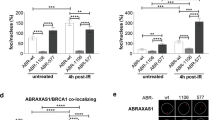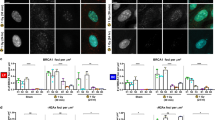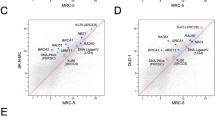Abstract
Structural abnormalities of chromosomes, including translocations and deletions, are extremely frequent in human cancer cells and particularly in breast cancer cells. One hypothesis to account for these alterations is a deficiency in the repair of DNA double-strand breaks (DSB). This repair process relies on two distinct pathways, homologous recombination (HR) and non-homologous DNA end joining (NHEJ). To investigate this latter pathway, we have studied the ability of cell-free extracts from a variety of human cells to rejoin different types of DSBs. The end joining activity of eleven sporadic breast cancer cell lines (BCCLs) was compared with that of control cells including primary human fibroblasts and cells harbouring a limited number of chromosome abnormalities. In vitro rejoining activity was not detected in extracts from MO59J DNA-PKcs-deficient cells and was strongly inhibited by wortmannin in control extracts. In contrast, most sporadic BCCLs and BRCA1 or BRCA2 deficient cells demonstrated similar efficiencies and accuracies of in vitro NHEJ than control cells. Only two BCCLs, SKBR3 and MDA-MB-453 exhibited decreased in vitro NHEJ. This study therefore indicates that a major defect in the NHEJ pathway is unlikely to account for the high number of chromosomes abnormalities observed in sporadic and hereditary BCCLs.
This is a preview of subscription content, access via your institution
Access options
Subscribe to this journal
Receive 50 print issues and online access
$259.00 per year
only $5.18 per issue
Buy this article
- Purchase on Springer Link
- Instant access to full article PDF
Prices may be subject to local taxes which are calculated during checkout





Similar content being viewed by others
References
Bell DW, Wahrer DC, Kang DH, MacMahon MS, FitzGerald MG, Ishioka C, Isselbacher KJ, Krainer M, Haber DA . 1999 Cancer Res. 59: 3883–3888
d'Adda di Fagagna F, Hande MP, Tong W, Roth D, Lansdorp PM, Wang Z, Jackson SP . 2001 Curr. Biol. 11: 1192–1196
Davidson JM, Gorringe KL, Chin SF, Orsetti B, Besret C, Courtay-Cahen C, Roberts I, Theillet C, Caldas C, Edwards PA . 2000 Br. J. Cancer 83: 1309–1317
Daza P, Reichenberger S, Gottlich B, Hagmann M, Feldmann E, Pfeiffer P, Li S, Ting NS, Zheng L, Chen PL, Ziv Y, Shiloh Y, Lee EY, Lee WH . 1996 Biol. Chem. 377: 775–786
Difilippantonio MJ, Zhu J, Chen HT, Meffre E, Nussenzweig MC, Max EE, Ried T, Nussenzweig A, Gao Y, Ferguson DO, Xie W, Manis JP, Sekiguchi J, Frank KM, Chaudhuri J, Horner J, DePinho RA, Alt FW, Karanjawala ZE, Grawunder U, Hsieh CL, Lieber MR . 2000 Nature 404: 510–514
Feldmann E, Schmiemann V, Goedecke W, Reichenberger S, Pfeiffer P . 2000 Nucleic Acids Res. 28: 2585–2596
Ferguson DO, Sekiguchi JM, Chang S, Frank KM, Gao Y, DePinho RA, Alt FW . 2000 Proc. Natl. Acad. Sci. USA 97: 6630–6633
Ford D, Easton DF, Stratton M, Narod S, Goldgar D, Devilee P, Bishop DT, Weber B, Lenoir G, Chang-Claude J, Sobol H, Teare MD, Struewing J, Arason A, Scherneck S, Peto J, Rebbeck TR, Tonin P, Neuhausen S, Barkardottir R, Eyfjord J, Lynch H, Ponder BA, Gayther SA, Zelada-Hedman M, Wu GJ, Sinclair CS, Paape J, Ingle JN, Roche PC, James CD, Couch FJ . 1998 Am. J. Hum. Genet. 62: 676–689
Forozan F, Mahlamaki EH, Monni O, Chen Y, Veldman R, Jiang Y, Gooden GC, Ethier SP, Kallioniemi A, Kallioniemi OP . 2000 Cancer Res. 60: 4519–4525
Gao Y, Ferguson DO, Xie W, Manis JP, Sekiguchi J, Frank KM, Chaudhuri J, Horner J, DePinho RA, Alt FW, Karanjawala ZE, Grawunder U, Hsieh CL, Lieber MR . 2000 Nature 404: 897–900
Hanakahi LA, Bartlet-Jones M, Chappell C, Pappin D, West SC . 2000 Cell 102: 721–729
Hiramoto T, Nakanishi T, Sumiyoshi T, Fukuda T, Matsuura S, Tauchi H, Komatsu K, Shibasaki Y, Inui H, Watatani M, Yasutomi M, Sumii K, Kajiyama G, Kamada N, Miyagawa K, Kamiya K, Wu GJ, Sinclair CS, Paape J, Ingle JN, Roche PC, James CD, Couch FJ . 1999 Oncogene 18: 3422–3426
Karanjawala ZE, Grawunder U, Hsieh CL, Lieber MR . 1999 Curr. Biol. 9: 1501–1504
Khanna KK, Jackson SP . 2001 Nat. Genet. 27: 247–254
Kytola S, Rummukainen J, Nordgren A, Karhu R, Farnebo F, Isola J, Larsson C . 2000 Genes Chromosomes Cancer 28: 308–317
Loveday RL, Greenman J, Simcox DL, Speirs V, Drew PJ, Monson JR, Kerin MJ . 2000 Int. J. Cancer 86: 494–500
Matsuda M, Miyagawa K, Takahashi M, Fukuda T, Kataoka T, Asahara T, Inui H, Watatani M, Yasutomi M, Kamada N, Dohi K, Kamiya K . 1999 Oncogene 18: 3427–3430
Moynahan ME, Chiu JW, Koller BH, Jasin M . 1999 Mol. Cell. 4: 511–518
Moynahan ME, Pierce AJ, Jasin M . 2001 Mol. Cell. 7: 263–272
Patel KJ, Yu VP, Lee H, Corcoran A, Thistlethwaite FC, Evans MJ, Colledge WH, Friedman LS, Ponder BA, Venkitaraman AR, Gao Y, Ferguson DO, Xie W, Manis JP, Sekiguchi J, Frank KM, Chaudhuri J, Horner J, DePinho RA, Alt FW, Karanjawala ZE, Grawunder U, Hsieh CL, Lieber MR . 1998 Mol. Cell. 1: 347–357
Pfeiffer P, Thode S, Hancke J, Vielmetter W . 1994 Mol. Cell. Biol. 14: 888–895
Rosenzweig KE, Youmell MB, Palayoor ST, Price BD . 1997 Clin. Cancer Res. 3: 1149–1156
Shen SX, Weaver Z, Xu X, Li C, Weinstein M, Chen L, Guan XY, Ried T, Deng CX . 1998 Oncogene 17: 3115–3124
Snouwaert JN, Gowen LC, Latour AM, Mohn AR, Xiao A, DiBiase L, Koller BH . 1999 Oncogene 18: 7900–7907
Thode S, Schafer A, Pfeiffer P, Vielmetter W . 1990 Cell 60: 921–928
Versteege I, Sevenet N, Lange J, Rousseau-Merck MF, Ambros P, Handgretinger R, Aurias A, Delattre O . 1998 Nature 394: 203–206
Wang H, Zeng ZC, Bui TA, DiBiase SJ, Qin W, Xia F, Powell SN, Iliakis G . 2001 Cancer Res. 61: 270–277
Yu VP, Koehler M, Steinlein C, Schmid M, Hanakahi LA, van Gool AJ, West SC, Venkitaraman AR . 2000 Genes Dev. 14: 1400–1406
Acknowledgements
We thank Lucien Cabanier for help in mass culture of cell lines. P Mérel was supported by the Association de Recherche contre le Cancer, P Pfeiffer by a fellowship of the Heisenberg programme of the Deutsche Forschungsgemeinschaft. This work was supported by grants from the Comité de Paris of the Ligue Nationale Contre le Cancer and from the Institut Curie (PIC Génétique et Biologie des Cancers du Sein).
Author information
Authors and Affiliations
Corresponding author
Rights and permissions
About this article
Cite this article
Mérel, P., Prieur, A., Pfeiffer, P. et al. Absence of major defects in non-homologous DNA end joining in human breast cancer cell lines. Oncogene 21, 5654–5659 (2002). https://doi.org/10.1038/sj.onc.1205742
Received:
Revised:
Accepted:
Issue Date:
DOI: https://doi.org/10.1038/sj.onc.1205742
Keywords
This article is cited by
-
Molecular contribution of BRCA1 and BRCA2 to genome instability in breast cancer patients: review of radiosensitivity assays
Biological Procedures Online (2020)
-
Mapping genetic alterations causing chemoresistance in cancer: identifying the roads by tracking the drivers
Oncogene (2013)
-
Etoposide-mediated glioblastoma cell death: dependent or independent on the expression of its target, topoisomerase II alpha?
Journal of Cancer Research and Clinical Oncology (2011)
-
Homologous repair of DNA damage and tumorigenesis:the BRCA connection
Oncogene (2002)



